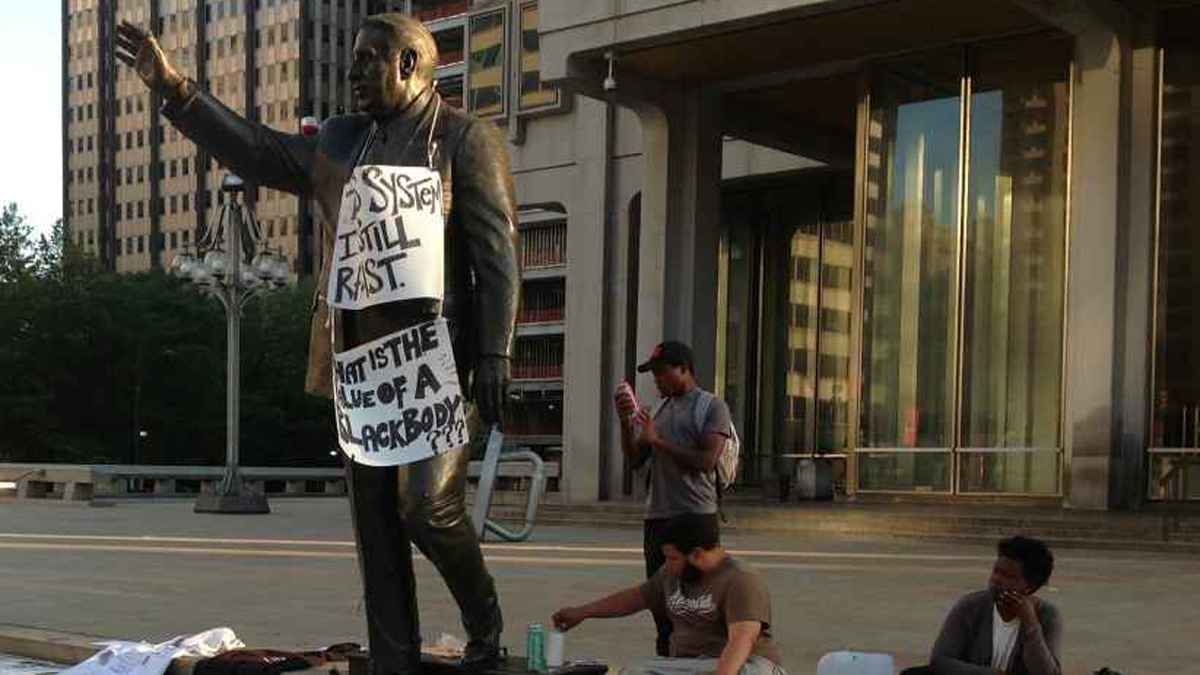Frank Rizzo statue should not greet DNC

(Courtesy Jaramogi Communications)
The Democratic National Convention arrives in Philadelphia just as our nation stands at a crossroads. Our politics is extreme, our views are divergent, and the actions of law enforcement are at the center of a national discussion on race.
The recent shooting deaths of Alton Sterling and Philando Castile, the latest in a string of African Americans shot by police, has awakened young protesters who rightly refuse to be silenced. Two gunmen who shot and killed eight police officers in Dallas and Baton Rouge have exacerbated the rage of conservatives.
But as the eyes of the world focus on Philadelphia, and the Democratic Party speaks of a national vision in which law enforcement treats African Americans equally, the history of police brutality that once ruled our city looms large. And it is encapsulated in a single statue.
Frank Rizzo—the police commissioner and mayor who stripped Black Panthers naked in the street, beat peaceful black teenage demonstrators, and oversaw a police force that the Pennsylvania Crime Commission said was rife with corruption—is immortalized in 10 foot bronze statue in the shadow of City Hall.
It’s time for the Frank Rizzo statue to come down.
At a time when national data compiled by the Washington Post show that unarmed African Americans are five times more likely than their white counterparts to be shot and killed by police, we can no longer celebrate the purveyors of police brutality. Not if we’re serious about change.
And make no mistake, Frank Rizzo, who once famously showed up in a tuxedo with a nightstick in his cummerbund to direct his officers, remains a strident symbol of police brutality in our nation.
Rizzo’s rough and tumble tactics in as Police Commissioner in the 1960s and as Mayor in the 1970s made him a cult hero of sorts, earning him nicknames like the Big Bambino and Cisco Kid.
In truth, Rizzo was a man whose use of force too often targeted racial minorities. And with the Republican candidate for president promising the same brand of “law and order” that Rizzo meted out as a Democratic police commissioner and mayor, it is incumbent upon today’s Democrats to acknowledge Rizzo’s place in America’s legacy of police brutality.
It is time for the Frank Rizzo statue to come down.
Why? The history is clear.
In 1967, when African American teens demonstrated peacefully at the School Administration Building, demanding that black history be taught in the public schools, then-Police Commissioner Frank Rizzo told his officers to attack male and female students, clerics, education officials and bystanders.
“I saw children who were fleeing from the police lying on the ground, each with three patrolmen beating them unmercifully with clubs,” Spencer Coxe, then-director of the Philadelphia chapter of the American Civil Liberties Union, told the Philadelphia Inquirer.
In 1977, after 10 Philadelphia police officers beat a black man for running a stop sign, breaking nightsticks over his head and shoulders in the process, then-Mayor Frank Rizzo said, “It’s very easy to break some of these nightsticks these days.”
And blacks weren’t the only victims.
In December 1977, six Philadelphia homicide detectives were convicted in federal court for beating and intimidating eight people during violent interrogations that resulted in the wrongful murder conviction of an innocent, mentally disabled white man.
Rather than condemning the officers’ actions, Rizzo said they were good men who did nothing wrong, telling reporters that they would stay on active duty “as long as I’m the mayor.”
By 1979, the U.S. Justice Department had filed a lawsuit against the Philadelphia Police Department, saying their unfettered use of brutality “shocks the conscience.”
In response, Rizzo said he’d never seen any brutality, a virtual impossibility in a police department known for the cruelty with which it carried out its mission.
Though Rizzo’s legacy continues to resonate in some corners of the Philadelphia Police Department, there is no doubt that the department has changed for the better. There are fewer police shootings, monthly meetings are held between police and community members, and in Police Commissioner Richard Ross, the department has a leader who is looking to build on those advances.
Be that as it may, when Democrats come to Philadelphia amid the rancor that has risen around the racial disparities in American policing, they should not see a statue of the man who made police brutality a cornerstone of our city’s culture.
If we are to move forward in making law enforcement a profession that respects the rights of every citizen equally, it is time for the Frank Rizzo statue to come down.
Listen to Solomon Jones weekdays 7-10 am on 900 AM WURD
WHYY is your source for fact-based, in-depth journalism and information. As a nonprofit organization, we rely on financial support from readers like you. Please give today.


